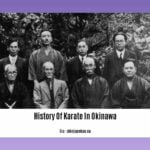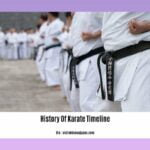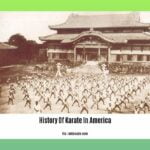Delve into the captivating world of karate in our comprehensive article: [- Historical Evolution and Transformative Techniques: A Journey through the History of Karate Facts]. Unravel the origins of this ancient martial art, tracing its evolution from its humble beginnings to its global prominence. Meet the legendary figures who shaped its techniques and discover how karate has influenced cultures worldwide. Explore the transformative power of this discipline, revealing its impact on self-defense, physical fitness, and personal growth.
Key Takeaways:
- Karate originated in East Asia over centuries and was systematized in Okinawa.
- It was likely developed by people who were forbidden to carry weapons.
- Karate was imported into Japan in the 1920s.
- The term “karate” means “empty hand” in Japanese.
- Karate began as a crude fighting style in Okinawa that grew and changed as it spread.
History Of Karate Facts

Karate, a martial art renowned for its powerful strikes and lightning-fast kicks, has a rich and fascinating history. Let’s delve into the origins and evolution of this captivating martial art.
Early Roots of Karate
The History of Karate Facts traces back to ancient East Asia, where unarmed combat techniques emerged centuries ago. It was in the 17th century that these techniques found a home in Okinawa, an island kingdom influenced by Chinese martial arts.
Birth of the “Empty Hand”
Okinawans refined these techniques, developing a rough fighting style called “te” or “ti.” History of Karate Facts reveal that the term “karate” (literally “empty hand”) emerged in the 1920s when the art was introduced to Japan and formalized.
Transformative Techniques
Over time, karate evolved into a sophisticated martial art. It incorporated techniques from various martial arts, including Chinese Kempo, Japanese jujutsu, and Okinawan kobudo (ancient weapon techniques). These influences shaped karate’s unique blend of strikes, throws, and blocks.
Global Impact
Karate’s popularity spread like wildfire, reaching Japan, the United States, and beyond. The influence of History of Karate Facts can be seen in cinema, popular culture, and various mixed martial arts.
Pioneers of Karate
A galaxy of masters played a pivotal role in the development of karate. Gichin Funakoshi, the “father of modern karate,” introduced the art to Japan, while Kanryo Higaonna and Shoshin Nagamine left an enduring legacy of Okinawan influences.
Modern Styles
Today, karate boasts a diverse range of styles, including Shotokan, Kyokushin, and Goju-ryu. Each style emphasizes different techniques, stances, and principles, offering practitioners a vast choice.
Karate and Self-Discipline
Beyond its physical prowess, karate fosters mental and spiritual development. Practitioners learn discipline, respect, and humility through rigorous training and adherence to ethical principles.
The Continued Evolution
The History of Karate Facts is a testament to the enduring power of human ingenuity and the pursuit of martial excellence. As karate continues to evolve, one thing remains certain: its rich legacy and transformative techniques will continue to inspire future generations.
For an in-depth look at the historical background of karate, delve into the comprehensive article on the history of karate. To uncover the historical roots of karate in Japan, explore the dedicated page on the history of karate in Japan. Discover the story of karate’s journey to America by exploring the history of karate in America page. For a detailed timeline of karate’s evolution, refer to the history of karate timeline for insights into its development. Delve into the origins of karate in history of karate in Okinawa to understand its roots in the islands. To unravel the significance of history of karate belts and their symbolic meanings, delve into the dedicated page exploring this aspect of karate.
Key Figures and Style Development

Journey with us as we explore the pivotal Key Figures who shaped the landscape of karate and the transformative Style Development that has made this martial art a global phenomenon.
Key Figures
Karate’s evolution owes much to its visionary masters. Giants like Gichin Funakoshi, Kanryo Higaonna, and Shoshin Nagamine dedicated their lives to refining and disseminating the art. Funakoshi, known as the “Father of Modern Karate,” brought karate to mainland Japan, while Higaonna brought Okinawan Goju-ryu to the forefront. Nagamine’s Kyokushin style emphasized full-contact sparring, pushing the boundaries of combat effectiveness.
Style Development
Karate’s rich history has given rise to a diverse array of styles, each with its unique flavor. Shotokan, known for its dynamic stances and powerful blows, traces its roots back to Funakoshi. Kyokushin’s emphasis on full-contact sparring and intense training has made it a favorite among fighters. Goju-ryu blends hard and soft techniques, creating a versatile style for both offense and defense.
Key Takeaways:
- Key Figures played a pivotal role in karate’s development and dissemination.
- Style Development has led to a diverse range of karate styles, each with its distinct characteristics.
- Karate’s evolution is an ongoing journey, constantly influenced by Key Figures and Style Development.
Sources
- Karate | Origin, Description, & History | Britannica
- History of Karate in Japan: Origins, Development, and Growth
Global Dissemination and Influence
We often hear the term “karate” tossed around in movies, TV shows, and even in our fitness classes. It’s an exciting martial art practiced by millions worldwide. But how did this fighting form reach far beyond its origins?
Karate started in Okinawa, a Japanese island, evolving from various Asian combat techniques. When Okinawa became part of Japan in the 1900s, karate spread to mainland Japan and eventually other countries.
Post-World War II, karate became popular among American servicemen stationed in Japan. They brought this knowledge back home, further spreading karate’s global dissemination and influence.
Key Takeaways:
- Karate originated in Okinawa.
- Global dissemination occurred through Japanese masters and American servicemen.
- Karate gained popularity in Japan and the US in the 1920s and 1950s.
- Its influence is seen in popular culture, martial arts, and self-defense training.
Sources:
Modern Adaptations and Variations: Exploring Karate’s Evolution
Key Takeaways:
- Karate’s roots lie in East Asian combat techniques, evolving in Okinawa and mainland Japan.
- Modern karate incorporates influences from various martial arts, blending strikes, throws, and blocks.
- Adaptive forms of karate, such as sport karate and Kyokushin, emerged to cater to specific needs.
- Karate’s popularity led to its global dissemination, including in the United States.
- Contemporary practitioners continue to explore innovative techniques, preserving karate’s relevance.
Evolution to Modern Adaptations
Karate has undergone significant transformations over time. The introduction of modern adaptations and variations has expanded its appeal and applicability.
- Sport karate: This competitive version emphasizes speed, accuracy, and athleticism. It incorporates elements of point scoring systems, tournaments, and distinct rules.
- Kyokushin: Known for its full-contact sparring, Kyokushin promotes resilience, toughness, and a test of will. It allows for punches, kicks, and grappling.
From Okinawa to the World
Karate’s journey from its Okinawan origins to its global recognition is a testament to its enduring appeal.
- In the 1920s, Japanese masters introduced karate to mainland Japan, where it gained popularity.
- US servicemen stationed in Japan after World War II brought karate back to the United States, establishing schools and promoting its widespread adoption.
- Today, karate is practiced in over 100 countries worldwide, with millions of practitioners.
Contemporary Innovations
Karate continues to evolve, with contemporary practitioners exploring new techniques and applications.
- Fitness karate: This variation incorporates karate movements and principles into a fitness regimen, emphasizing cardiovascular health and body conditioning.
- Hybrid karate: Blending elements from multiple karate styles, practitioners create unique combinations that cater to their specific goals.
- MMA karate: Influenced by mixed martial arts (MMA), this variation focuses on combining karate techniques with other fighting disciplines.
Citations:
- Karate | History, Rules, & Techniques | Britannica
- The Evolution of Karate in Modern Times: Adapting to the 21st Century
FAQ
Q1: When and where did karate originate?
A1: Karate originated over centuries in East Asia, becoming systematized in Okinawa in the 17th century.
Q2: Why and how was karate developed?
A2: Karate was likely developed by people forbidden to carry weapons. It emphasizes using the body’s natural force to deliver powerful strikes and blocks.
Q3: When and how was karate introduced to Japan?
A3: Karate was imported into Japan in the 1920s. It was introduced by Japanese masters who taught it to soldiers during World War II.
Q4: Where does the term “karate” come from?
A4: The term “karate” stems from Japanese words meaning “empty hand.”
Q5: What are the key characteristics of karate?
A5: Karate is an unarmed martial art that emphasizes kicking, striking, and defensive blocking. It focuses on concentrating power for maximum impact and has developed different schools and systems with varying techniques and training methods.
- Mastering Leader in Spanish: The Complete Guide - April 19, 2025
- Uncovering Surprising Parallels: England Size Compared to US States - April 19, 2025
- Old Mexico Map: Border Shifts 1821-1857 - April 19, 2025
















